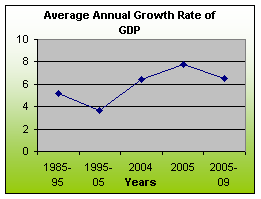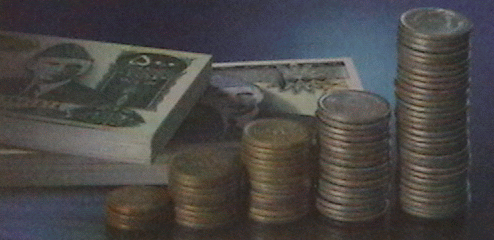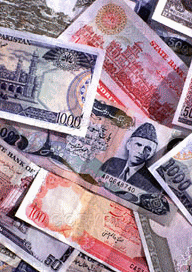

Economy of Pakistan


 At the time of independence, the
economy of the newly born state was abysmal, since during the British times, all
industrial infrastructure was laid in what constituted India in 1947. Although
Pakistan had inherited 20 per cent of the subcontinent's population, her share
in industry was less than 7 per cent, consisting mostly of small-scale and minor
industrial units: the 34 factories did not total up to a daily employment of
more than 26, 400 persons. The East wing which produced 70 per cent of the
world's jute, had not a single jute mill since all jute mills were located in
Calcutta, India and was thus the almost sole buyer. In the West wing, only 16000
of the total 1500000 cotton bales produced could be processed domestically.
Pakistan did not have a single ordinance factory and other major industrial
units. The new state does not have its own bank and depends on the reserve bank
of India.
At the time of independence, the
economy of the newly born state was abysmal, since during the British times, all
industrial infrastructure was laid in what constituted India in 1947. Although
Pakistan had inherited 20 per cent of the subcontinent's population, her share
in industry was less than 7 per cent, consisting mostly of small-scale and minor
industrial units: the 34 factories did not total up to a daily employment of
more than 26, 400 persons. The East wing which produced 70 per cent of the
world's jute, had not a single jute mill since all jute mills were located in
Calcutta, India and was thus the almost sole buyer. In the West wing, only 16000
of the total 1500000 cotton bales produced could be processed domestically.
Pakistan did not have a single ordinance factory and other major industrial
units. The new state does not have its own bank and depends on the reserve bank
of India.
However, starting from scratch and collecting papers from rubbish, the Pakistani officials and office staff picked bits and pieces together and started building up the new country. Now after some six decades, Pakistan is a fast growing country. Pakistan witnessed a steady pace of economic growth in the 60s with major thrust on agro-based industry, specially cotton, which however slowed down in the 80s/90s due to inept governments. However for the first time after the 60s, the steps taken at the macro level by the present government under General Pervez Musharraf, the economic outlook of the country has brightened and finally there is a hope of prosperity for its generally poor people. Since 1999, the foreign exchange reserves have swelled from disgusting US $ 500 million (when the country was being governed by the "democratically elected government") to over US $ 12 billion. For the first time the exports have crossed US $ 1 billion mark.
|
Pakistan Tops Dollar Bond Performance in Asia 24-04-2009: Despite continued uncertainty, the world's largest dollar bond investors are continuing to maintain holdings in Pakistan. According to HSBC, Pakistani bonds have returned 35 percent this year, the best performance in Asia among dollar debt indexes compiled by London-based HSBC. ING Groep NV, Erste Sparinvest KAG and HSBC Holdings Plc, which oversee more than $800 billion in assets, are maintaining holdings of Pakistan’s dollar bonds as almost $13 billion in assistance from the International Monetary Fund and aid pledges help the country stave off default. Pakistan’s 6.875 percent dollar bond maturing in June 2017 yielded 18.62 percent yesterday, versus a record high of 26.30 percent on Nov. 3, 2008, according to data compiled by Bloomberg. The Karachi stock index is up 27 percent this year, compared with a 12 percent gain in MSCI’s emerging-market stock index. Pakistan also won promises this month for $5.3 billion in aid from more than 20 countries to help shore up its economy and combat al-Qaeda and Taliban militants.( Reference ) |
|
Past and the Present |
|
|
The Past Under the Military Regime |
The Present (and the Future?? ) |
|
The military rule that stretched from 1999 to early 2008, had many ups and finally a bleak down. From thriving economy and building of Forex reserves from mere US $ 500 miilion to all time US $ 16 billion, lot of water flowed under the bridge. As per the Ministry of Finance, Government of Pakistan, despite an extra-ordinary surge in oil prices and the devastation caused by the earthquake of October 8, 2005 Pakistan's economy continued to maintain a solid pace of expansion in 2005-06. Pakistan's economy has proved itself as remarkably resilient in the face of shocks of extra-ordinary proportions. The magnitude of growth that Pakistan has achieved during the last four years in a row has positioned Pakistan as one of the fastest growing economies in the Asian region. This growth momentum is underpinned by wide-ranging structural reforms, macroeconomic stability, and consistency and continuity in policies.
The GDP growth remained in the 6-8% range in
2004-06. In 2005, the World Bank
named Pakistan the top reformer in its region and in the top 10 reformers
globally.
Pakistan has three stock exchanges, established each in Karachi, Lahore and Islamabad. The Karachi Stock Exchange (KSE) is the more dynamic and volume based as compared to the rest of the two. The KSE was initially 50 50 companies based, but was elevated to KSE-100 on 1 November, 1991 and presently ranks as one of the most accepted Exchange in the region. The KSE-100 is a capital weighted index and represents about 86 percent of market capitalization of the Exchange. In 1995 the KSE all share index was constructed and introduced on September 18. The KSE has seen an up rise trend recently, though after crossing 10,000 mark, it plummeted a few months ago, crashing billions of rupees of investors. However, it has again picked up and at this time, the KSE-100 index has crossed 11,000 mark. The Lahore (LSE) and Islamabad (ISE) stock markets are heavily affected by performance of KSE - in fact all three stock exchanges rise and fall together. Karachi Stock Exchange was declared as the “Best Performing Stock Market of The World" in 2002. KSE has been well into the 3rd year of being one of the Best Performing Markets of the world as declared by the international magazine “Business Week”. Similarly the US newspaper, USA Today, termed Karachi Stock Exchange as one of the best performing bourses in the world. |
However, soon cracks started appearing in the economy in the early 2008, mainly due to soaring oil prices and which multiplied the oil bill many times. Suddenly a well meaning economy started to crumble - The inflation which continued to rise in previous years, though at a lower pace, suddenly jumped to almost 29% in 2008 as compared to 9% in 2005 The rupee currently stands at 80 against one US dollar whereas just six months ago, one dollar was equal to Rs 60. The country’s trade deficit stands at 12 billion dollars, which is the highest ever in its 61-year old history. The country's stock exchanges are at all time low and there is no signs of recovery. Once thriving KSE-100 index of over 15000 points is at a record low around 9,187 on 21 November 2008. The 2008 onwards, Pakistan's economic is nose diving rapidly and alarmingly. The State Bank of Pakistan, though enforced
tighter monetary grip, could not harness the growing inflation and the
current account deficit - driven by a widening trade gap as import growth
outstrips export expansion - and had to draw down reserves and dampen GDP
growth in the medium term. As of now, Pakistan urgently
needs at least $3 billion -- and as much as $5 billion and has requested the
IMF for as much as $10 billion. "If Pakistan doesn't get the money, there
may be a repeat of freezing foreign currency accounts, foreign currency
rationing and, eventually, a default on its sovereign loans," the Minister
in-charge for economic affairs, Mr Shaukat Tarin is reported to have said.
The government hopes that China, the United States or Saudi Arabia would
lend cash or oil rebates, but all three have made it clear they aren't able
or willing to do that just yet. So today Pakistan's economy stands at a crossroads - either to take a healthy upward trend or continue with the stalemate. Many believe for the good since Pakistan with its external debt to GDP ratio of 28% is much better placed as compared to Iceland's 545% and Ukrainian's 71%. |
Related Links: | Official Website: Ministry of Finance GOP | Economy of Pakistan | Index of Economic freedom 2008 | Economic Freedom Scores |
|
| HOME PAGE | Copyright©JalalsPages - 2005 - 2008 |